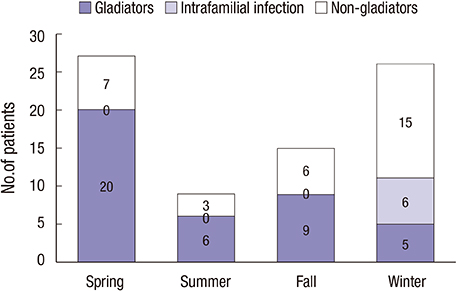J Korean Med Sci.
2016 Feb;31(2):296-300. 10.3346/jkms.2016.31.2.296.
Skin Infection due to Trichophyton tonsurans Still Occurs in People in Korea but not as Outbreaks
- Affiliations
-
- 1Department of Dermatology, Kyungpook National University School of Medicine, Daegu, Korea. weonju@knu.ac.kr
- 2Institute of Medical Mycology, Catholic Skin Clinic, Daegu, Korea.
- KMID: 2360056
- DOI: http://doi.org/10.3346/jkms.2016.31.2.296
Abstract
- Since 1995, Trichophyton tonsurans has been one of the causative agents of dermatophytosis in Korea. Herein we evaluate 77 patients infected with T. tonsurans who visited an outpatient clinic between 2004 and 2014. Infections due to T. tonsurans were diagnosed by mycological examination, which included direct microscopic examination using 15% KOH and culture in potato dextrose agar complemented with 0.5% chloramphenicol. The annual prevalence of infection due to T. tonsurans was the highest in 2014 (15 cases) but remained constant in non-gladiators between 2004 and 2014. The ratio of male to female patients was 1:0.3. The spring season presented the highest incidence compared with other seasons, with 27 cases. The incidence of infections due to T. tonsurans among gladiators was highest in spring compared with the other seasons whereas the incidence in non-gladiators was the highest in the winter. The body site most commonly affected was the face. Tinea corporis was the most common subtype of dermatophytosis caused by T. tonsurans. Herein, we demonstrate that the prevalence of infection with T. tonsurans remain constant throughout the study period in Korea.
Keyword
MeSH Terms
Figure
Cited by 2 articles
-
Low But Continuous Occurrence of
Microsporum gypseum Infection in the Study on 198 Cases in South Korea from 1979 to 2016
Weon Ju Lee, Jun Hong Park, Jun Young Kim, Yong Hyun Jang, Seok-Jong Lee, Yong Jun Bang, Jae Bok Jun
Ann Dermatol. 2018;30(4):427-431. doi: 10.5021/ad.2018.30.4.427.Analysis of Adult Patients with Tinea Capitis in Southeastern Korea
Hyun Ji Lee, Jun Young Kim, Kyung Duck Park, Yong Hyun Jang, Seok-Jong Lee, Yong Jun Bang, Jae Bok Jun, Weon Ju Lee
Ann Dermatol. 2020;32(2):109-114. doi: 10.5021/ad.2020.32.2.109.
Reference
-
1. Suh SB, Kim SW, Oh SH, Choi SK, Bang YJ. A case of block dot ringworm caused by trichophyton tonsurans. Korean J Dermatol. 1998; 36:918–923.2. Kim HY, Kim SL, Lee WJ, Lee SJ, Kim DW, Jun JB. Intra-familial infection due to Trichophyton tonsurans in Korean general population. Korean J Med Mycol. 2014; 19:105–109.3. Hiruma J, Ogawa Y, Hiruma M. Trichophyton tonsurans infection in Japan: epidemiology, clinical features, diagnosis and infection control. J Dermatol. 2015; 42:245–249.4. Alshawa K, Lacroix C, Benderdouche M, Mingui A, Derouin F, Feuilhade de Chauvin M. Increasing incidence of Trichophyton tonsurans in Paris, France: a 15-year retrospective study. Br J Dermatol. 2012; 166:1149–1150.5. Mochizuki T, Tanabe H, Wakasa A, Kawasaki M, Anzawa K, Ishizaki H. Survey of Trichophyton tonsurans infection in Japan. Molecular epidemiology and factors affecting adequate hairbrush sampling. Nippon Ishinkin Gakkai Zasshi. 2006; 47:57–61.6. Fuller LC, Child FC, Midgley G, Higgins EM. Scalp ringworm in south-east London and an analysis of a cohort of patients from a paediatric dermatology department. Br J Dermatol. 2003; 148:985–988.7. Choi SK, Lee YH, Oh SH, Kim SW, Bang YJ, Suh SB. Three cases of kerion celsi caused by Trichophyton tonsurans. Korean J Med Mycol. 1998; 3:179–184.8. Sung SY, Kim HY, Kim HU, Ihm CW. Trichophyton tonsurans infection in wrestlers and a child. Korean J Dermatol. 1998; 36:732–736.9. Kim KH, Kim KS, Lee JM, Shin DH, Choi JS. A case of tinea corporis caused by Trichophyton tonsurans in an American girl living in Korea. Korean J Dermatol. 1998; 36:666–669.10. Kim GI, Yim YS, Park CW, Lee CH. A case of kerion celsi caused by Trichophyton tonsurans. Korean J Dermatol. 2000; 38:691–694.11. Lim JY, Jang HS, Oh CK, Kwon KS, Kim MB. Two cases of kerion celsi caused by Trichophyton tonsurans. Korean J Dermatol. 2002; 40:286–290.12. Jun JB, Kim YD. The epidemiological, clinical and mycological studies on Trichophytosis Gladiatorum prevailing among Korean wrestlers. Korean J Med Mycol. 2004; 9:28–44.13. Jun JB, Choi SK. Epidemiological, clinical and mycological studies of Trichophytosis Gladiatorum prevailing among Korean judoists. Korean J Med Mycol. 2004; 9:100–111.14. Jun JB, Chung H. Trichophyton tonsurans infection in a judoist girl and her mother. Korean J Med Mycol. 2004; 9:123–127.15. Park JS, Kim SW, Jun JB, Suh SB, Bang YJ. Clinical and epidermiologic study of Trichophyton tonsurans infections (1995~2003). Korean J Med Mycol. 2004; 9:197–205.16. Lee DK, Lee HW, Chang SE, Lee MW, Choi JH, Moon KC, Koh JK. A case of diffuse black dot tinea capitis caused by Trichophyton tonsurans. Korean J Med Mycol. 2005; 10:160–165.17. Park BC, Choi YS, Lee WJ, Jun JB. Intra-familial transmission of Trichophyton tonsurans. Korean J Med Mycol. 2006; 11:27–30.18. Kim MS, Kim DH, Choi KC, Chung BS. A case of kerion celsi caused by Trichophyton tonsurans in adult female patient. Korean J Dermatol. 2006; 44:1256–1258.19. Ko WT, Kim SH, Suh MK, Ha GY, Kim JR. A case of kerion celsi caused by Trichophyton tonsurans. Korean J Med Mycol. 2007; 12:208–213.20. Oh S, Choi S, Lee S, Lee J, Choi Y. Toe nail onychomycosis caused by Trichophyton tonsurans in a healthy child. Korean J Med Mycol. 2011; 16:206–210.
- Full Text Links
- Actions
-
Cited
- CITED
-
- Close
- Share
- Similar articles
-
- Trichophyton tonsurans Infection in Wrestlers and a Child
- Trichophyton tonsurans Infection in a Judoist Girl and Her Mother
- Intra-familial Infection due to Trichophyton tonsurans in Korean General Population
- A Case of Tinea Pseudoimbricata by Trichophyton tonsurans
- Three Cases of Kerion Celsi Caused by Trichophyton tonsurans






